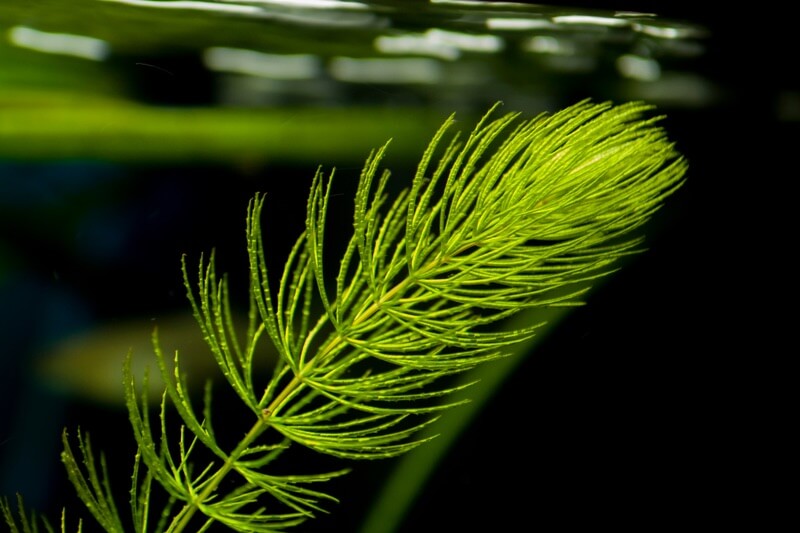If you’re considering adding some plants to your aquarium, hornwort is a fantastic choice.
It’s easy to care for, looks great, and is readily available at any aquarium store. Not only that, but it’s compatible with all kinds of fish.
Because of the popularity hornwort has in the aquarium community, we put together this guide to make caring for your hornwort plant nice and easy!
Table of Contents
Summary
As we mentioned above, hornwort (Ceratophyllum) is one of the most popular freshwater aquarium plants out there. It’s a go-to option for anyone looking to add a little plant life to their tank.
Why is it so popular?
It’s simple. hornwort is affordable, easy to care for, and very hardy.
It’s also a plant that can either float or root itself. This gives you options for how you decide to use it in your aquarium. It can serve the purpose of providing shade, or be used simply to improve the aesthetic appeal of your tank.
It can handle cold water very well and in the wild, it survives the winter by creating turions. Turions are essentially pieces of the plant that get released and sink to the bottom of whatever body of water it’s in.
These turions wait at the bottom of the water for winter to end. And when things warm up, they sprout.
The exact number of hornwort species is undefined, but the safe bet is somewhere between 115 and 150. It’s such a prevalent plant that it’s considered an invasive species in certain parts of the world.
This is partly due to its hardy nature, but it has another trick up its sleeve. Through allelopathy, hornwort can hinder other plants ability to grow. This gives is quite a competitive advantage.
Because of this, the plant can be found all over the world. In fact, the only place it hasn’t been found yet is Antarctica!
Appearance
Hornwort is a green plant that has multiple stems that branch out and give the appearance that one plant is actually several. In the wild, these can grow to be up to ten feet in length.

It has small leaves that grow out of these stems and are evenly spaced all the way to the top of the plant. These leaves (sometimes referred to as needles) are typically no longer than one inch in length from top to bottom.
They are soft to the touch and make the stem look kind of like a cats tail. There aren’t many leaves per group (usually no more than twelve) and are only about an inch long.
Fish Compatibility
This is a common question that we see online from people who are considering adding hornwort to their aquarium.
Fortunately, hornwort is a great aquarium roommate.
You don’t have to worry about identifying suitable tankmates with this plant. It goes great with everything!
While some of the animals in your tank won’t notice or interact with the hornwort much at all, others will.
Hornwort can be considered a snack for some fish. Certain species like Gouramis will probably eat the plant. This might not be that big of a deal depending on your fish to plant ratio, but it’s something to consider.
When your hornwort sheds (more on this later) scavenging critters in your tank will enjoy these little snacks. This is good for you since you’ll have a cleaner tank, and good for them!
Also, guppies, mollies, Endler’s livebearers, and platy fish will likely use your hornwort as a place for fry if they’re mating. This goes for any freshwater live-bearer that you have in your aquarium.
Why You Should Consider Adding It To Your Aquarium
There are a number of benefits to adding hornwort to your aquarium.
The first is that this plant does a great job of knocking down the amount of nitrate in your tank. While you can’t rely on hornwort to take care of any nitrate problems completely, you’ll definitely notice a difference.
Hornwort is also an easy way to spruce up the look and feel of your tank. It adds to the overall aesthetic appeal of your aquarium and gives it a more organic and natural look.
It’s can be a lot of fun to watch your fish interact with it as it moves around in the current. When you see the before and after difference, you’ll wonder how you ever enjoyed your tank without it!
There are some other functional benefits to having hornwort in your aquarium as well. Since it’s a plant, hornwort creates oxygen via photosynthesis. As you can imagine this can be very good for your tank.
Your fish will thrive and enjoy the influx of fresh oxygen in your tank. The whole goal behind keeping an aquarium is to mimic the natural environment and to keep your fish healthy.
Adding hornwort will help you do this.
It’s also a great source of shelter and shade which will provide enrichment for your fish and help them give each other the necessary space to remain stress-free.
A lot of beginners think that adding plants to their tank might make it too crowded and force fish into more interactions with each other. However, as long as you don’t put too many plants in your tank the opposite will likely happen.
How To Take Care Of Hornwort
While hornwort is a very hardy aquarium plant and able to handle a variety of different environments, there are certain things you need to do if you want it to thrive.
Fortunately, caring for hornwort is pretty simple. Let’s take a look at the things you need to be mindful of.
Tank Size
The ideal tank size for hornwort is very flexible, so you don’t need to spend much time worrying about this. Like we mentioned earlier, it can grow to be up to ten feet tall in the wild.
This means if you have a large tank it will grow to fit it just fine. However, if your aquarium is a bit smaller, you can just prune and trim your hornwort to make sure it doesn’t outgrow its home.
The general rule of thumb for minimum tank sizes is around 15 gallons. This isn’t a set in stone rule and we’ve known people who keep hornwort in 10 gallon tanks with seemingly no problem. The catch is that they’re pruning it constantly (hornwort is a very fast grower).
So if you want to use it in a small tank without having to give it a frequent haircut, the 15-gallon rule is probably wise.
Water Conditions
The hardiness and flexibility that hornwort possess mean you can throw a variety of water conditions at them without needing to worry. It’s very similar to dwarf hairgrass in that regard. With that being said, there is a sweet spot (a large one) where it can thrive comfortably:
- pH level: 6-7.5
- Water temperature: 59°F to 86°F / 15°C to 30°C
- Water hardness: 5-15 dGH
As you can see, these are some pretty wide acceptable ranges. This makes hornwort an easy addition for more aquarium owners. We recommend adding some fertilizer on a regular basis (usually once a week) in order to make sure it has the necessary amount of nutrients as well.
You’ll obviously still need to use a filter for the sake of keeping nitrates, nitrites, and ammonia levels under control but that’s something you would be doing for your fish anyway.
Ideal Lighting
Since it is a plant, it needs sunlight to survive. Make sure your water is clean and you have a light that’s powerful enough to provide your plant with the necessary amount of rays.
Fortunately, it only needs a small amount of light intensity to survive. No need to run out and pick up a massive lamp, but you might have to upgrade from any kit lighting you have.
If you’re floating your hornwort (more on this below) then it will have no trouble getting a sufficient amount of light, even if your tanks water isn’t crystal clear. However, if you’ve planted it then the water clarity becomes more important.
Regardless, make sure your water is clean!
To Float Or Not To Float
As we’ve mentioned already, hornwort is a plant that can float or be planted. It’s versatile like that!
However, this leads to a common dilemma among prospective hornwort buyers. That’s why so many new aquarists ask if there one choice that’s significantly better than the other.
But it really comes down to a mix of personal preference and the kind of fish you have.
If you own surface-dwelling fish then floating your hornwort might be the best option. This will give them something to hide in and interact with.
For fish that dwell near the bottom or middle of your tank, planting your hornwort is probably the better call.
We always default to what’s best for the life in your tank, but it’s worth considering the look and feel that you want it to add as well.
If you decide to float it, simply drop it in your aquarium and let it do its thing.
You’ll want to mindful of the rapid growth that this plant is capable of when doing this. A decent amount of shade can quickly turn into zero light whatsoever if you don’t manage this.
Planting your hornwort is a little trickier.
Before it can grow its anchoring stems, you’ll need to provide a little extra help to ensure that your hornwort doesn’t float to the surface. A common trick to make this happen is to take suction cups and pin the base of the stem to the bottom of the tank.
This will allow your plant to anchor itself to the bottom without causing any harm to the plan itself. You’ll be surprised how fast this process can occur!
Things To Watch Out For
There isn’t a whole lot you need to deal with once you’ve added hornwort to your aquarium. It’s a pretty low maintenance plant.
But just like anything in your aquarium, problems can arise from time to time. Here are some common issues and what you can do to take care of them.
Managing Rate Of Growth
The main thing you need to keep an eye on when adding hornwort to your aquarium is the insane speed that it grows.
It’s fast.
Because of this, there are some things you have to do to maintain the health of your plant and the tank. It’s pretty low maintenance overall, but not completely hands-off.
To deal with the speed that it grows you’ll need to clip/prune the stems from time to time. If you neglect this you’ll quickly end up with a massive beast of a plant.

When this happens the hornwort can prevent its tankmates from thriving by blocking out light. This obviously impacts any other plants you have in your tank, but it isn’t good for your fish either.
The amount that you clip it is dependant on the size of your tank, if you choose to float it or not, and the kind of fish that you have. There isn’t a fixed rule for this, just use common sense and you’ll be fine!
Lastly, you want to make sure that your hornwort isn’t growing too close to your filter intake. This is easy to spot.
Dealing With Shedding
Your hornwort plant might shed a little from time to time. If this happens, simply collect any excess leaves that can clog things up or dirty break down in your tank.
If this shedding goes from being a minor occurrence to a full-on leaf evacuation, you’ll want to diagnose the issue. The most likely causes are poor water conditions, or lighting that isn’t ideal (can be too much or too little).
Discoloration
In some cases, your hornwort might change colors and turn brown or yellow (both extremely attractive and health colors).
For those of you who have/will deal with brown hornwort let us put your mind at ease right away. Browning is a totally normal color that your plant will sometimes take on. This is caused by a healthy amount of light, so don’t panic!
However, if your hornwort is beginning to turn yellow it’s cause for concern. Unfortunately, there isn’t one consistent culprit for whenever this happens, so you’ll need to do some detective work and figure out what’s causing it.
The usual suspects are a good place to start (we’re really loving the cop phrases apparently). Here they are for your convenience:
- Poor lighting. Just like with any plant, a lack of light will drastically impact the health of your hornwort. Make sure to you have a proper lamp and nothing is preventing the light from reaching your plant. Dirty water with a planted hornwort is a common recipe for disaster here.
- Water quality. Run some quick tests on your water to make sure everything is looking good in your tank. Not enough iron is a common issue that can lead to your plant turning yellow, so keep an eye out for that result.
How To Propagate Hornwort
If you want to propagate your hornwort and turn your plant into the gift that keeps on giving, here’s the super simple process you’ll need to use:
Step 1: Take a side stem and chop it off
Step 2: Place this newly separated stem somewhere else in the tank (either by floating or planting it)
Step 3: Watch your new hornwort plant grow!
Yeah, it’s really that easy.
This should help demonstrate how this plant has been so successful (and invasive) in the wild. While it can be an issue for certain parts of the world, it makes propagating hornwort a piece of cake.
Conclusion
By now you should have a good base of knowledge about hornwort and how to take care of them in your tank. As I’m sure you’ve realized by now, they’re very low maintenance and offer a wide variety of benefits for your tank.
If you have a freshwater aquarium and are considering adding a plant, hornwort is a great choice.

